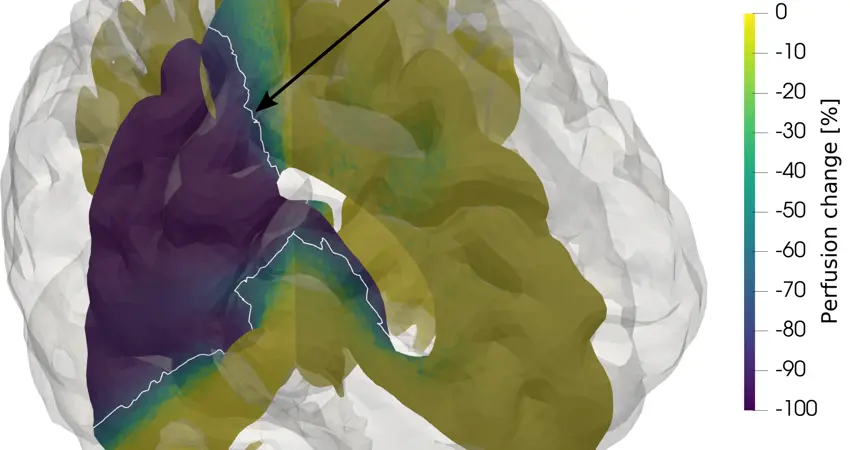26 Jan 2021
Computer simulations may assist surgeons in stroke treatment decisions
New research from the INSIST consortium suggests that computer simulations could be used to develop more efficient treatments for stroke patients.

Annually, approximately 13 million people suffer from strokes around the globe resulting in more than 5 million mortalities. Acute ischaemic stroke, caused by the blockage of a large blood vessel (artery) in the brain, accounts for most cases. The corresponding treatments target the removal of the blood clot responsible for the blockage either chemically with blood thinner, or mechanically with a catheter. Depending on patients’ conditions, blood clot properties, and many other factors, surgeons need to decide whether chemical, mechanical, or even combined treatment is the best.
A 3D visualisation of the human brain and blood vessels. Credit: Raymond Padmos and Tamás Józsa
Currently, such decisions rely solely on complex, resource-intensive and time-consuming experiments and clinical trials. The INSIST consortium aims to utilise computer simulations to ease surgeons’ dilemma. Similar simulation tools are widely used to tackle challenges in mechanical, civil, and chemical engineering. The application of these engineering methods in biomedical research is becoming feasible thanks to rapidly expanding clinical databases which provide solid foundations for software development.
The INSIST consortium is a group of researchers from multiple universities, including Dr Tamás Józsa, Dr Wahbi El-Bouri and Professor Stephen Payne from the Cerebral Haemodynamics Group at the Institute of Biomedical Engineering, Department of Engineering Science. The consortium explores simulation tools to accelerate and to cut the cost of the development of stroke treatments, which is currently a lengthy and expensive process. The latest research comes in three papers, one of which is led by Tamás, and another is co-authored by Tamás, Wahbi and Stephen. Tamás explains the current status of the field, “A virtual human organ models the behaviour of a real organ on a computer and allows us to investigate different medical scenarios. The development of virtual human organs is in its infancy. Because of the complexity of the human body, most studies to date have been limited to a single organ in a few healthy patients. ”
Blood clot removal using a stent retriever. Credit: Giulia Luraghi.
The first paper presents the model developed by Dr Giulia Luraghi, which provides previously unseen details about removing blood clots with stent retrievers (a cylindrical wire mesh placed inside a blood vessel to remove obstructions). In the second paper, Raymond Padmos’ simulations shed light on how clots alter blood flow in large cerebral arteries. Giulia and Raymond are members of the Computational Biomechanics and Computational Science labs, and work with Professors Francesco Migliavacca & José Rodríguez Matas (Politecnico di Milano), and Professor Alfons Hoekstra (University of Amsterdam), respectively.
An ‘infarction’ (region of dead tissue) forms from a lack of blood supply, caused by a blood clot. Credit: Tamás Józsa
Tamás’ model, presented in the third paper in the recent announcement, accounts for blood flow in the smallest capillary vessels of the brain, which play an important role in the formation of infarcts – regions of dead tissue which form due to a lack of blood supply. Tamás explains, “For the first time, our simulations capture how a clot causes blood flow shortage in the brain which is directly responsible for tissue death during stroke. Thanks to the INSIST consortium, we will be able to model the key aspects of stroke & the related treatments, and investigate a large cohort of virtual patients.”
Giulia, Raymond and Tamás used pre-existing engineering methods for their models, as Tamás adds, “From the engineering point of view, blood flows through the smallest blood vessels of our brain like oil leaks through tiny cracks of a rock. Large blood vessels are similar to potable water networks and the frame of a stent retriever to the frame of a bridge. However, there is a major difference: the properties of the elements of man-made systems are well known. The same cannot be said of our body.”
Beyond the development of these unique computational models, the research team has shown strong evidence that, based on experiments, the simulation results are reliable. Tamás says, “We are excited about the integration of these models which have functioned independently to date. The interacting models will help us to find promising treatments, for instance, by minimising brain tissue loss. We hope that the software suite we are creating will help to improve clinical practice.” There are also wider applications to this research, “We are planning to expand the INSIST modelling framework in the future to gain an in depth understanding of other conditions associated with blood flow deficiencies, such as sickle cell anaemia and vascular dementia.”




